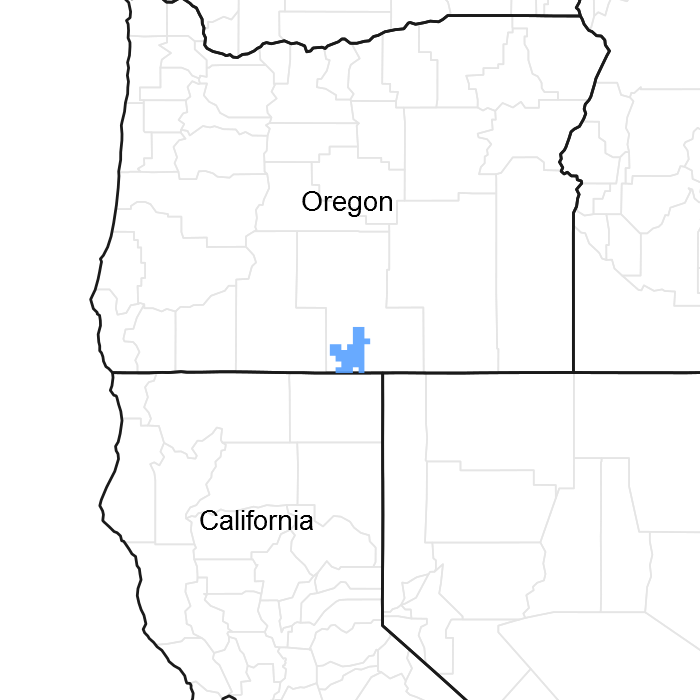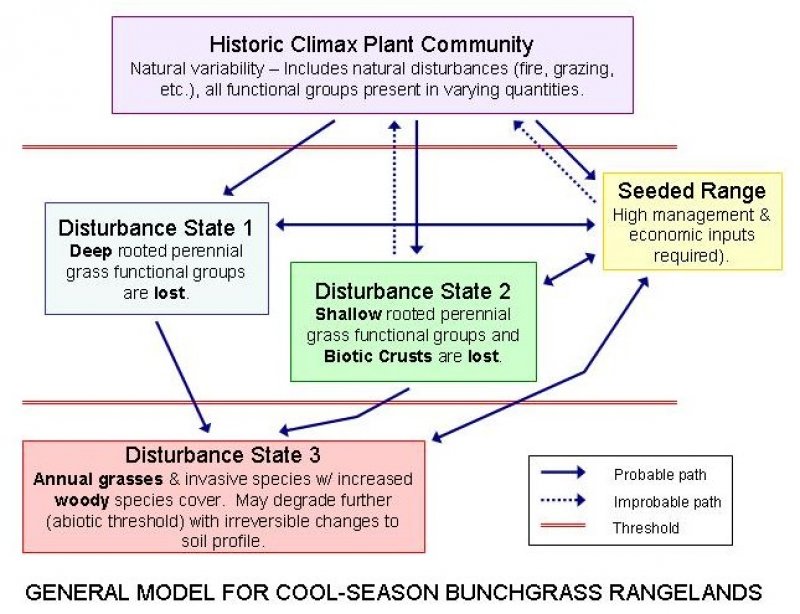
Natural Resources
Conservation Service
Ecological site R021XY100OR
DRY FLOODPLAIN 10+ PZ
Accessed: 12/06/2025
General information
Provisional. A provisional ecological site description has undergone quality control and quality assurance review. It contains a working state and transition model and enough information to identify the ecological site.

Figure 1. Mapped extent
Areas shown in blue indicate the maximum mapped extent of this ecological site. Other ecological sites likely occur within the highlighted areas. It is also possible for this ecological site to occur outside of highlighted areas if detailed soil survey has not been completed or recently updated.
Associated sites
| R021XY200OR |
LOAMY 10-14 PZ |
|---|
Table 1. Dominant plant species
| Tree |
Not specified |
|---|---|
| Shrub |
Not specified |
| Herbaceous |
Not specified |
Physiographic features
This site occurs on floodplains.
Table 2. Representative physiographic features
| Landforms |
(1)
Flood plain
|
|---|---|
| Elevation | 122 – 1,585 m |
| Slope | 0 – 2% |
| Aspect | Aspect is not a significant factor |
Climatic features
The annual precipitation ranges from 10 to 14 inches, most of which occurs in the form of snow during the months of October through April. The soil temperature regime is mesic with the mean annual air temperature of about 47 degrees F. Temperature extremes range from 110 to -30 degrees F. The frost free period ranges from 70 to 110 days. The optimum period for plant growth is from early May through June.
Table 3. Representative climatic features
| Frost-free period (average) | 110 days |
|---|---|
| Freeze-free period (average) | 0 days |
| Precipitation total (average) | 356 mm |
Figure 2. Monthly average minimum and maximum temperature
Influencing water features
Soil features
The soils of this site are very deep and moderately well drained. The soils are subject to occasional flooding for brief periods during the spring snow melt period. A water table is present below 30 inches throught the summer. Typically the surface layer is loam or silty clay loam about 15 inches thick. The subsoil and subtratum is loam, clay loam, or sandy clay loam. Permeability is moderatley slow. The available water holding capacity is about 9 to 12 inches. Runoff is very slow. Erosion hazard by water is slight except along streambanks during periods of flooding.
Table 4. Representative soil features
| Surface texture |
(1) Loam (2) Silt loam |
|---|---|
| Family particle size |
(1) Loamy |
| Drainage class | Moderately well drained |
| Permeability class | Moderately slow |
| Soil depth | 152 cm |
| Available water capacity (0-101.6cm) |
22.86 – 30.48 cm |
Ecological dynamics
If the condition of the site deteriorates as a result of overgrazing, grasses will decrease and big sagebrush, green rabbitbrush and other shrubs will increase. Continual spring use will drastically reduce the basin wildrye. Long term degradation and lack of fire will encourage invasion of the site by western juniper.
This site is occasionally flooded and receives supplemental moisture from fluctuations in groundwater levels. Differeneces in productivity and plant composition may occur in cases where gravel stringers evidence that recent meanders of the steam channel. Where stream entrenchment has occurred, site production decreases and plant composition changes to more drought tolerant, upland species. As precipitation exceeds 14 inches or more, or where there is cold air drainage in the bottomland, currant and snowberry will increase.
State and transition model

More interactive model formats are also available.
View Interactive Models
More interactive model formats are also available.
View Interactive Models
Click on state and transition labels to scroll to the respective text
Ecosystem states
State 1 submodel, plant communities
State 1
HCPC, LECI4/ARTRT-PUTR2
Community 1.1
HCPC, LECI4/ARTRT-PUTR2
The potential native plant community is strongly dominated by basin wildrye with lesser amounts of Nevada and Canby bluegrasses. Big sagebrush, antelope bitterbrush and snowberry are common. Vegetative composition of the community is approximately 85% grasses, 5% forbs, and 10% shrubs.
Figure 3. Annual production by plant type (representative values) or group (midpoint values)
Table 5. Annual production by plant type
| Plant type | Low (kg/hectare) |
Representative value (kg/hectare) |
High (kg/hectare) |
|---|---|---|---|
| Grass/Grasslike | 1883 | 2125 | 2367 |
| Shrub/Vine | 135 | 242 | 350 |
| Forb | 108 | 202 | 296 |
| Total | 2126 | 2569 | 3013 |
Figure 4. Plant community growth curve (percent production by month). OR5501, D21 Low Elev., NA, Meadow/Lakebed/Irr.. RPC Growth Curve.
| Jan | Feb | Mar | Apr | May | Jun | Jul | Aug | Sep | Oct | Nov | Dec |
|---|---|---|---|---|---|---|---|---|---|---|---|
| J | F | M | A | M | J | J | A | S | O | N | D |
| 0 | 0 | 0 | 5 | 15 | 30 | 35 | 10 | 5 | 0 | 0 | 0 |
Additional community tables
Table 6. Community 1.1 plant community composition
| Group | Common name | Symbol | Scientific name | Annual production (kg/hectare) | Foliar cover (%) | |
|---|---|---|---|---|---|---|
|
Grass/Grasslike
|
||||||
| 1 | Dominant deep rooted perennial grasses | 1749–2018 | ||||
| basin wildrye | LECI4 | Leymus cinereus | 1749–2018 | – | ||
| 3 | Dominant shallow rooted perennial grasses | 81–215 | ||||
| Sandberg bluegrass | POSE | Poa secunda | 81–215 | – | ||
| 5 | Other perennial grasses | 54–135 | ||||
| slender wheatgrass | ELTR7 | Elymus trachycaulus | 0–6 | – | ||
| Idaho fescue | FEID | Festuca idahoensis | 0–6 | – | ||
| prairie Junegrass | KOMA | Koeleria macrantha | 0–6 | – | ||
|
Forb
|
||||||
| 7 | Dominant perennial forbs | 54–161 | ||||
| common yarrow | ACMI2 | Achillea millefolium | 27–81 | – | ||
| lupine | LUPIN | Lupinus | 27–81 | – | ||
| common yarrow | ACMI2 | Achillea millefolium | 27–81 | – | ||
| lupine | LUPIN | Lupinus | 27–81 | – | ||
| 9 | Other perennial forbs | 54–135 | ||||
| Brown's peony | PABR | Paeonia brownii | 0–6 | – | ||
| phacelia | PHACE | Phacelia | 0–6 | – | ||
| woolly plantain | PLPA2 | Plantago patagonica | 0–6 | – | ||
| mullein | VERBA | Verbascum | 0–6 | – | ||
|
Shrub/Vine
|
||||||
| 11 | Dominant evergreen shrubs | 108–215 | ||||
| basin big sagebrush | ARTRT | Artemisia tridentata ssp. tridentata | 54–135 | – | ||
| antelope bitterbrush | PUTR2 | Purshia tridentata | 54–81 | – | ||
| 15 | Other shrubs | 27–135 | ||||
| green rabbitbrush | ERTE18 | Ericameria teretifolia | 0–6 | – | ||
| golden currant | RIAU | Ribes aureum | 0–6 | – | ||
| wax currant | RICE | Ribes cereum | 0–6 | – | ||
| rose | ROSA5 | Rosa | 0–6 | – | ||
| common snowberry | SYAL | Symphoricarpos albus | 0–6 | – | ||
Interpretations
Animal community
This site provides excellent food and cover for deer and quail.
Hydrological functions
The soils are in hydrologic group C.
Recreational uses
This site offers great potential for deer and upland game bird observation and hunting.
Other products
This site is suited to cattle and sheep grazing in all seasons under a planned grazing system. The position of this site in the landscape and its productivity encourages livestock concentaration, making it subject to heavy grazing pressure. Use should be postponed until soils are firm enough to prevent trampling damage and soil compaction.
Other information
In fair conditions this site rapidly responds to good management. Fire is an exellent tool for the control of big sagebrush. In poor condition, this site has potential for reseeding.
Supporting information
Contributors
Carlson, Barrett
E Ersch (OSU)
K.Kennedy
Rangeland health reference sheet
Interpreting Indicators of Rangeland Health is a qualitative assessment protocol used to determine ecosystem condition based on benchmark characteristics described in the Reference Sheet. A suite of 17 (or more) indicators are typically considered in an assessment. The ecological site(s) representative of an assessment location must be known prior to applying the protocol and must be verified based on soils and climate. Current plant community cannot be used to identify the ecological site.
| Author(s)/participant(s) | Jeff Repp |
|---|---|
| Contact for lead author | Oregon NRCS State Rangeland Management Specialist |
| Date | 08/21/2012 |
| Approved by | Bob Gillaspy |
| Approval date | |
| Composition (Indicators 10 and 12) based on | Annual Production |
Indicators
-
Number and extent of rills:
None, slight sheet & rill erosion hazard except along streambanks during periods of flooding -
Presence of water flow patterns:
None, except for natural overflow areas -
Number and height of erosional pedestals or terracettes:
None -
Bare ground from Ecological Site Description or other studies (rock, litter, lichen, moss, plant canopy are not bare ground):
<5% -
Number of gullies and erosion associated with gullies:
None -
Extent of wind scoured, blowouts and/or depositional areas:
None, slight wind erosion hazard -
Amount of litter movement (describe size and distance expected to travel):
Fine to coarse - limited movement except during flooding -
Soil surface (top few mm) resistance to erosion (stability values are averages - most sites will show a range of values):
Significantly resistant to erosion: aggregate stability = 4-6 -
Soil surface structure and SOM content (include type of structure and A-horizon color and thickness):
Very deep, moderately well drained loams and silty clay loams: Moderate OM (1-5%) -
Effect of community phase composition (relative proportion of different functional groups) and spatial distribution on infiltration and runoff:
High ground cover (80-90%) and gentle slopes (0-2%) effectively limits rainfall impact and overland flow, infiltration can be limited by excess thatch -
Presence and thickness of compaction layer (usually none; describe soil profile features which may be mistaken for compaction on this site):
None -
Functional/Structural Groups (list in order of descending dominance by above-ground annual-production or live foliar cover using symbols: >>, >, = to indicate much greater than, greater than, and equal to):
Dominant:
Basin wildrye > Sandberg bluegrass = other forbs = dominant shrubs > dominant forbs > other shrubsSub-dominant:
Other:
Additional:
-
Amount of plant mortality and decadence (include which functional groups are expected to show mortality or decadence):
Normal decadence and mortality expected -
Average percent litter cover (%) and depth ( in):
-
Expected annual annual-production (this is TOTAL above-ground annual-production, not just forage annual-production):
Favorable: 3000, Normal: 2400, Unfavorable: 1800 lbs/acre/year at high RSI (HCPC) -
Potential invasive (including noxious) species (native and non-native). List species which BOTH characterize degraded states and have the potential to become a dominant or co-dominant species on the ecological site if their future establishment and growth is not actively controlled by management interventions. Species that become dominant for only one to several years (e.g., short-term response to drought or wildfire) are not invasive plants. Note that unlike other indicators, we are describing what is NOT expected in the reference state for the ecological site:
Perennial brush species will increase with deterioration of plant community. Western Juniper readily invades the site. Cheatgrass and Medusahead invade sites that have lost deep rooted perennial grass functional groups. -
Perennial plant reproductive capability:
All species should be capable of reproducing annually
Print Options
Sections
Font
Other
The Ecosystem Dynamics Interpretive Tool is an information system framework developed by the USDA-ARS Jornada Experimental Range, USDA Natural Resources Conservation Service, and New Mexico State University.
Click on box and path labels to scroll to the respective text.